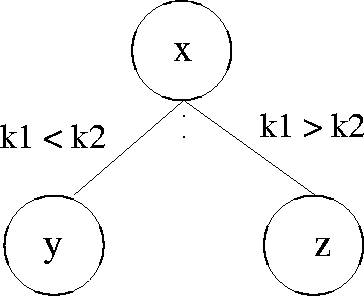The worst case complexity of any sorting algorithm that only uses key comparisons is
![]() (nlog
n)
(nlog
n)
Result 2
The average case complexity of any sorting algorithm that only uses key comparisons is
![]() (nlog
n)
(nlog
n)
The above results are proved using a Decision Tree which is a binary tree in which the nodes represent the status of the algorithm after making some comparisons.
Consider a node x in a decision tree and let
y be its left child and zits right child. See Figure
9.4.
 |
Basically, y represents a state consisting of the information
known at
x plus the fact that the key k1
is less than key k2. For a decision tree for insertion
sort on 3 elements, see Figure 9.5.
 |